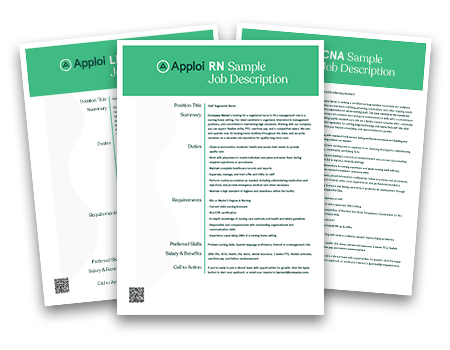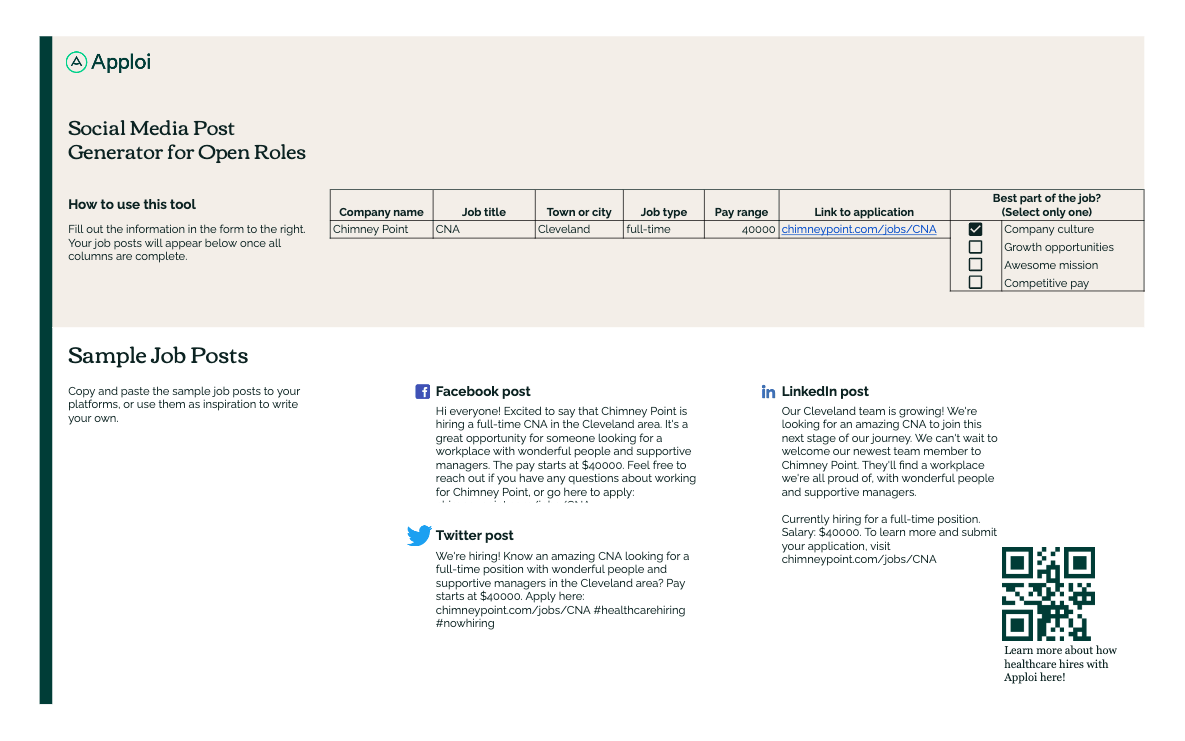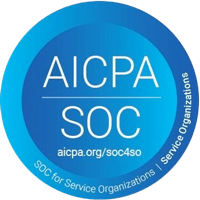Where and How Healthcare Employers Find Qualified Candidates
No matter how much you’ve streamlined your hiring process, it won’t make much of a difference if you haven’t been able to source qualified candidates.
Attracting qualified candidates is easier said than done. To stay competitive in today’s fierce healthcare hiring market, you need to get creative with a diverse mix of recruiting tactics.
Here are some of the best channels for healthcare candidates, and how to use them.

FREE TEMPLATES
Create effective job posts to attract more candidates with our free templates for RN, CNA, and LPN job descriptions
1. Job Boards
Posting on job boards is a tried-and-tested way of attracting candidates. You probably already use job boards in your hiring efforts. But that doesn’t mean you can’t be creative with your posts. What makes your organization stand out? Highlight those unique attributes in the job ad, and use the posting to link to social media or other platforms where candidates can learn more about your work culture.
How to Use Job Boards To Find Qualified Candidates
- Save time by investing in software that can distribute postings to job boards automatically
- Start with highly popular, cross-industry job boards. General job boards are helpful for entry-level positions. Since you might train these candidates yourself (or they might not need specific training), it makes sense to target job seekers who aren’t exclusively focused on healthcare.
- Consider focusing on healthcare-specific job boards for highly specialized healthcare roles.
- Make it easy for qualified candidates to find your job through search engine optimization. Include important keyphrases, such as “full time” or “Chicago nursing jobs,” in both the title and body of your post.
- Use your job board’s unique functionality to your advantage. For example, some job boards (like Indeed) offer pre-screening questions. Schedule time with a representative to understand the tools at your disposal.
- If you have the budget, consider investing in job sponsorships, especially if you’re interested in increasing your application volume quickly.
2. Employee Referrals
Employee referrals are a cost-effective way to find qualified candidates. In fact, LinkedIn reports that employers save $7,500 in productivity and sourcing costs for every employee hired through employee referrals. Not to mention, referred candidates are 55% faster to hire, compared with employees sourced through career sites. Candidates who come through these programs have already been pre-screened by the employee who referred them, so they’re likely a good cultural fit for your business.
Strategy
- Create a robust incentive program, and get creative about rewards—remember that you’ll be saving money from hiring costs in the long run. You can even include experiential rewards and incentives, such as gift cards, tickets for events, and more.
- Regularly remind employees about the referral program. It can be easy to forget about evergreen programs.
- Make it a competition. Announce a contest with a reward for the employee who refers the highest number of candidates.
- Create easy-to-use referral forms. Link to these in newsletters, on your website, or in your employee portal.
3. In-house Training
If you’re wondering how to source candidates who are perfectly trained for your roles, an in-house training program might be the answer. In-house training programs can be an excellent way to find and prepare candidates, especially for high turnover positions like CNAs. With in-house training, you can be in control of what your trainees learn, and be sure that your new hires are equipped to do their jobs.
Strategy
- Consider offering your training for free or for a low cost. With high turnover, you will ultimately save money by reducing hiring costs.
- Create mentor/mentee relationships during training, connecting current employees with trainees. Make sure the employees you choose as mentors are excited about the mentoring program.
- Advertise widely. Make sure everyone in your company is aware of the program so they can refer their friends and spread the word.
Strategy
- Experiment with channels. There are dozens of social media platforms to choose from, and you may not have a large enough team to maintain a robust presence on every one. Try seeing which platforms bring you the most qualified candidates in the short term, and focus on those.
- Experiment with content. Your base could respond to strategies that you might not expect. Do you get more engagement when you use humor? A lot of text? Video? Memes? Try different content strategies, and stick to one that feels authentic while driving engagement.
- Build your social media presence with content that isn’t just job posts. Over time, you’ll build a base of people who are genuinely interested in your company, and who are more likely to reach out for a position.
FREE Social Media Job Post Generator
Copy & Paste the perfect job post with our free generator
5. In-Person Events
Many healthcare professionals are in high demand. It’s not uncommon for those with highly sought after qualifications (physical and occupational therapists, for example) to have jobs lined up before graduation.
Don’t fall behind. Connect with local high schools, colleges, and certification programs to speak to students before they become candidates. Besides schools, it pays to be a presence in the community. Digital marketing is crucial, but in-person connections with community members can really build your reputation.
Strategy
- Attend pre-existing local events, such as job fairs, especially if you don’t have the time or budget to host your own events.
- Connect with local high schools and colleges. Consider offering promising candidates job offers or training offers before they graduate. Remember, you’re not just competing with other senior living facilities, you’re competing with other healthcare fields. Get on students’ radar early, especially if you’re in an industry (like senior living) that’s struggling to attract new talent.
- Flyers can be a low-cost companion to digital recruitment marketing. Consider posting them in high traffic local areas, like libraries and community centers.
6. Return to Past Applicants
You may already have a pool of candidates: your past applicants. Reach out to qualified candidates from the past to see if they’d be interested in reapplying. Focus on candidates who you believed would make good employees, but who you couldn’t hire at the time, due to budget, time conflicts, etc.. Some former applicants may return to the hiring process with more experience under their belt, making them even stronger candidates for your roles.
Strategy
- Leave the door open in your hiring process. Let promising candidates know you’d like to keep their resumes on file even if you aren’t able to hire them.
- Even if you have interviewed a candidate in the past, do it again before extending a new offer. Your candidates’ needs and qualifications may have changed while you weren’t in touch.
- Make use of a standardized rejection letter template. Keep your tone professional and polite to reduce any negative feelings from candidates who you may reconnect with in the future.
- Invite candidates to sign-up for job alerts in the event that new positions open up. Nurturing candidates via email is a great way to keep your organization top of mind and reduce negative employer brand sentiment.
7. Rehire Past Employees
Similarly, rehiring past employees can also help bolster your workforce. Rehired employees are making a conscious choice to return, which could improve their retention long term. In fact, 55% of rehired employees reported higher satisfaction levels than before.
Strategy
- Take into account why your past employees left. Make sure potential friction is addressed before making the rehire.
- Just like with past candidates, it’s important to re-interview and assess. Your former employee’s needs and experience has likely changed in the time they were gone.
- Encourage honesty in the rehiring process. If your employee feels comfortable sharing why they left, you can better adjust to support them.
8. Promote from Within
According to Harvard Business Review, the chance of employee turnover increases by 1% every ten months they remain in the same role. When you promote employees, you simultaneously reduce turnover and increase morale. As you gain a reputation as an employee who values career growth, word of mouth will also bring new qualified candidates to your hiring pool.
Strategy
- Ask about career goals in the interview, and continue to check in with employees regularly. Include career goals in your discussion of their performance evaluations.
- Provide access to what trainings you can, and consider educational stipends to help employees pursue further credentials.
- Leverage internal promotions. Not only do promotions increase employee morale, but it can also help you fill certain positions faster.
Better Hiring With Apploi
Apploi can help you effectively distribute jobs, advertise on social media, and build a long-term hiring strategy. Interested in learning more about how you can recruit, hire, and onboard healthcare staff quickly? Contact us today for a free demo of our talent management solution.




4. Social Media
Social media has become one of the most powerful tools for recruitment. In fact, according to Glassdoor, 79% of job seekers use social media to aid their job search.
With social media, you have endless opportunities to be creative with your content. You can use social media platforms to develop a strong brand voice, call for applications, and show off culture.